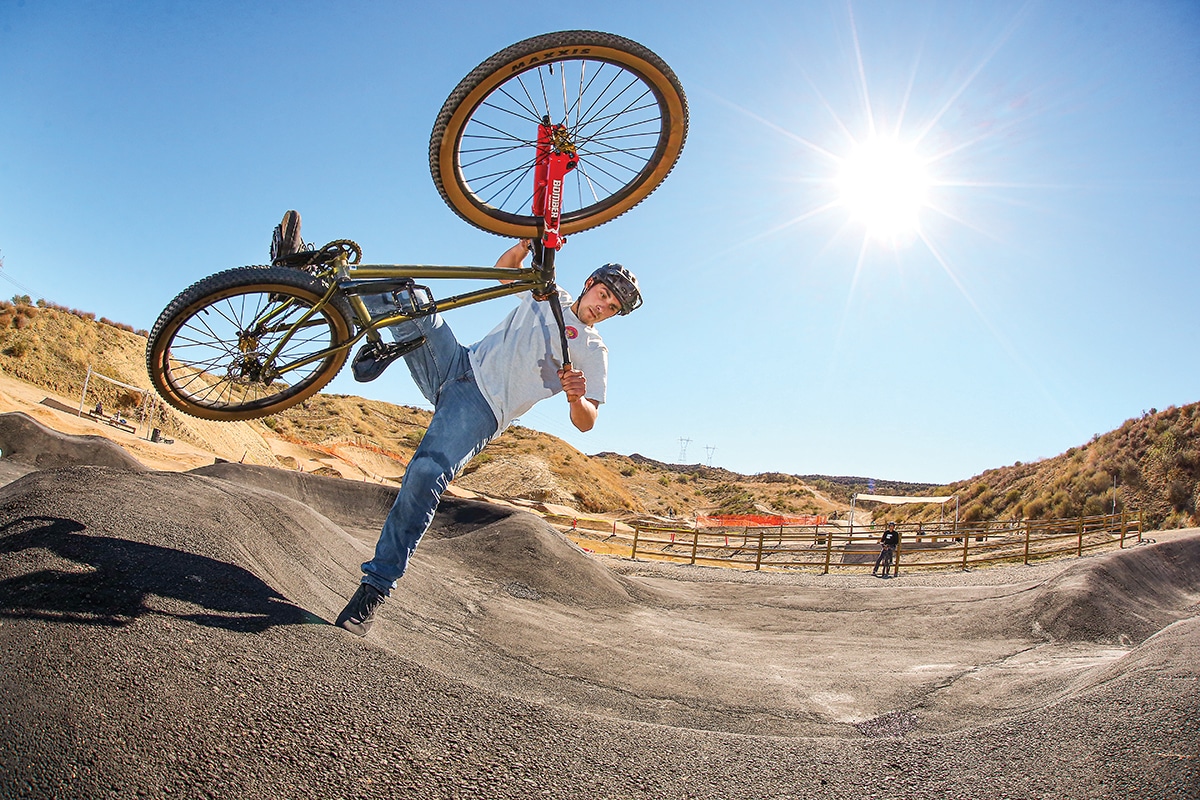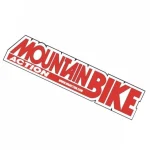The Ultimate Pump-Track Guide
The Ultimate Pump-Track Guide
By
 What truly makes dirt jump bikes so much fun is their simplicity. Many of these bikes only have a rear brake and most have only a single gear.
What truly makes dirt jump bikes so much fun is their simplicity. Many of these bikes only have a rear brake and most have only a single gear.
As kids, many of us likely dreamed of spending time at the BMX track or skatepark, which allowed us to have hours of fun without leaving the confines of a rather small area. As we got older, we started to venture out into the woods, pushing our bigger bikes to the limits over rocks, roots, jumps and more. That childhood dream is still alive in many of us, and knowing that you don’t need to strand yourself in the middle of nowhere to ride is quite a nice feeling. Across the globe, pump tracks have become the perfect environment for reliving childhood antics and teaching new skills to riders of all ages. Before we get too carried away, though, let’s take a moment to step back and discuss what a pump track actually is.

WHAT’S A PUMP TRACK?
In its simplest form, a pump track is a set of dirt or paved rollers and berms designed to be ridden without pedaling. How is that possible? Well, by using the right pumping techniques, which we’ll touch on later, riders can create momentum through sets of rollers, allowing them to carry speed through turns and back into another set of rollers. Pump-track designs can vary from just a small backyard project to larger machine-built tracks. The idea, however, is the same whether you have 2-foot-tall rollers in your backyard or 6-foot paved rollers at a city-funded track. Once the general idea is in place, the sky is the limit on what a pump track can be turned into. In fact, some more advanced riders will often jump their way through these tracks as they better understand how to create speed and carry it throughout the course.

WHAT DO YOU NEED?
To optimize your pump-track experience, a hardtail bike is often preferred; however, not just any hardtail will do the trick. The best option is a bike with wheels ranging from 20 inches to 26 inches. Yup, you read that right. Pump tracks are not designed for big-wheel machines, but don’t get discouraged if you only have one bike. With a few tricks, you could be generating speed around the track in no time. To maximize fun, a BMX or dirt jump-style bike is key. The good news is that these bikes often cost much less than full-suspension trail machines.
Used BMX and dirt jump bikes can be found for around a few hundred dollars. Meanwhile, more serious riders can spend upwards of a few thousand dollars for a top-end model or custom build.
If you have to bring your full-suspension bike to the track, we know a few tricks that might enhance your experience. First things first, you’ll want your suspension components as stiff as possible to help create forward momentum when pumping. A squishy bike will soak up the rollers instead of generating speed through them. The best option is to use your compression adjustments or lock-out switches to firm up the suspension as much as possible. Tire pressure can also be increased, considering these tracks are often as smooth as butter. While your fun might be optimized on a purpose-built bike, we encourage you to give your local pump track a chance on whatever bike you have in the garage. Once you get the bug, however, you’re likely to invest in another steed.

OUR SECRET WEAPON
The Mountain Bike Action crew was lucky enough to have a city-funded track built right in our hometown. There are also quite a few tracks within a few hours’ drive of our home base. To take full advantage of these tracks, we built a dream machine that’s capable enough to handle the rigors of a Red Bull Joyride event. That said, we want to further stress that a used dirt jumper or a BMX bike for around a few hundred bucks will be more than sufficient for most riders to enjoy a day of pumping.
Our build started out with a Kona Shonky frame and a purpose-built Marzocchi DJ fork. Complete Shonky bikes from Kona can be purchased for around $1400. Meanwhile, framesets cost $575. The reason we opted for a dirt jump bike over a BMX bike is that many of our mountain bike parts can transfer over, helping us stay on budget while reaping top performance. Here’s a quick overview of our custom build.
Frame: 2021 Kona Shonky (Short)
Our build began with a Kona Shonky frame with sliding thru-axle dropouts and a threaded bottom bracket.
Fork: Marzocchi Bomber DJ (100mm of travel)
The Bomber DJ is a dirt jump-specific fork made for 26-inch wheels. It features a 36mm chassis, along with an oversized, 20mm axle. An adapter kit allows riders the option of a 15mm axle.
Wheels: Industry Nine 305 DJ wheels (single-speed hub)
The most exciting component on our build is the custom set of Industry Nine wheels. We had a pair of 26-inch Enduro 305 rims laced around gold Hydra hubs. To keep the rear end looking neat, we ran a single-speed rear hub with a shorter freehub body.
Rear cog: Endless Bike Co. Kick A’ cog (14t)
Endless Bike Co. makes some really cool CNC-machined cogs and chainrings. We used their 14-tooth Kick A’ cog on our build. The cog was combined with a 32-tooth front chainring that provided a good ratio for dirt jumps, pump tracks or street riding.
Freehub spacers: Reverse Components Single Speed Spacer Kit
Reverse Components offers a wide selection of parts for riders wanting to convert their bikes to single-speed. Our Kona has red Reverse Components spacers along with a red lock-ring.
Tires: Maxxis Ikon (26×2.2”)
Maxxis hooked us up with a set of tires that would have been a cross-country racer’s dream back in the early 2000s. These tan-walled Ikons are built for speed and provide additional confidence off road compared to street-worthy dirt jump tires.
Crankset: SRAM GX Eagle (170mm, 32t)
It would have been easy to get carried away with a fancy crank on this bike, but at the end of the day, it is a jump bike built to handle daily abuse. A SRAM GX Eagle crankset seemed like a no-brainer. We would have liked a 165mm crank with a 30-tooth chainring for clearance and reduced chain length, but we haven’t had any issues with our 170mm crank and 32-tooth ring.
Chain: Sram GX Eagle 12-speed chain
To ensure maximum chain retention, we opted for a SRAM chainring and chain combo.
Handlebar: Burgtec Ride High Josh Bryceland Signature alloy handlebar
These 38mm-tall bars from Burgtec are a perfect pick for enduro, trail or dirt jump bikes. We cut ours down from 800 to 770mm.
Stem: Burgtec Enduro MK3
A bronze Burgtec stem adds some flair to our ride, along with some serious performance. At 42.5mm long with a 35mm clamp area, the MK3 was exactly what this dream bike needed.
Grips: Deity Lockjaw
The Lockjaw grips from Deity offer a super-soft and cushy feel that works great without gloves.
Seatpost: Burgtec Xpress carbon
To keep things light and to add to the bling factor, we placed a carbon fiber seatpost from Burgtec on this build. Fun fact: this is the same post the Santa Cruz Syndicate runs on its World Cup Downhill race bikes.
Saddle: Deity Speedtrap
A bronze Deity Speedtrap saddle provides a place to sit when coasting to and from the bike park.

PROGRESS YOUR SKILLS
Pump tracks are not only a fun way to get out and experience a new type of riding, they are also a beneficial way to build important skills that transfer to the trails. Once you’ve mastered the correct technique for generating speed, you’ll find ways to mimic this movement on natural rollers found all over your local trails. This valuable skill is what allows elite riders to generate downhill speed without taking a single pedal stroke. Additionally, pump tracks teach riders that momentum is their friend. Slamming on the brakes in a corner will drastically slow a rider down and forfeit the momentum gained by his previous pumping efforts. Riders who learn how to create speed and carry it through turns will quickly find themselves descending trails faster than ever before.

So, what exactly does pumping your bike mean? Of course, we’re not talking about pumping up your tires, so what could this term be referring to? Well, the motion of pumping your bike can be broken down into a few steps. The first step is finding your attack position where your body is relaxed yet ready to move and take on impacts. Once you approach a roller, allow the front wheel to roll over the top and begin to straighten your legs and move your body forward. The next step is where all the magic happens. As the front wheel comes over the roller, keep some pressure on the front end to keep the wheel planted. Then, as your back tire rolls over the roller, shift your weight back behind the axle to generate forward energy.
Developing this skill will require a lot of practice; however, one good pump can be felt almost immediately. With a purpose-built bike, only a small amount of body movement is needed, while full-suspension bikes require more pronounced movements to overcome the added squish. Keep at it and you’ll be generating your own speed without the use of your gears. If you happen to be struggling with the motion of pumping, try removing your chain to force yourself not to pedal. A chain-less run around the track can be quite revealing and educational.
FUN FOR ALL AGES
Truly the best part of pump-track riding is that it’s fun for all ages. In fact, some venues even have a kids’ track designed for younger ones so they can practice in a safe environment. Pump tracks are truly for everyone. From advanced riders looking to perfect their skills to new riders looking to master the art of cornering on berms or generating speed without pedaling, pump tracks are something every city needs. If you haven’t had the pleasure of giving one of these tracks a spin, we highly recommend that you do so. Check out websites such as www.pumptracks.com where you can locate tracks across the world, from American to Africa. We also recommend getting involved with your city to push projects like this through. The benefits to your community will be enormous.




